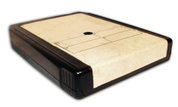8-Track Players
The 8-track cartridge is a now-obsolete audio storage magnetic tape cartridge technology, popular from the late 1960s to the early 1980s. The 8-track was created by Bill Lear in 1964 at Lear Inc. more...
(the company of Lear Jet fame), after he heard Earl "Madman" Muntz's 1962 Stereo-Pak 4-track stereo tape system, which had been inspired in turn by the 1959 Fidelipac 3-track tape cartridge system used by radio broadcasters for commercials and jingles.
The original format for magnetic tape sound reproduction was reel-to-reel audio tape recording, first made available in the 1940s. However, the machines were bulky and the reels themselves were more difficult to handle than vinyl records. Born from the desire to have an easier to use tape format, the enclosed reel mechanism was introduced in the mid 1950s.
Development
The endless loop tape cartridge was designed in 1952 by Bernard Cousino of Toledo, Ohio, around a single reel carrying a continuous loop of standard 1/4 inch plastic oxide-coated recording tape. Program starts and stops were signalled either by a conductive foil splice or sub-audible tones. The 8-track version simplified the mechanism by rolling the motorized metal capstan in the player against a pinch wheel installed inside the cartridge to pull the tape across the player's read head (in the earlier 4-track Stereo-Pak, the pinch wheel was part of the player and flipped into the cartridge through a hole). The tape was pulled from the center of the reel, passed across the opening at the end of the cartridge and wound back onto the outside of the same reel. The spool itself was freewheeling and the tape was driven only by tension from the capstan.
The tape was coated with a slippery backing material patented by Cousino, usually graphite, to ease the continuous slip between the tape layers. This coating sometimes also caused the pinch wheel to slip, leading to poor speed control and tape flutter. Due to these problems, 8-track cartridges were never popular with audiophiles. While the design allowed simple and cheap players, unlike a two-reel system it didn't permit winding of the tape in either direction. Some players offered a limited fast-forward by speeding up the motor while cutting off the audio but rewinding was impossible.
Muntz's 4-track Stereo-Pak cartridge had four monaural or two pairs of stereo tracks. A foil splice passed across a pair of contacts close to the read head, signalling the player to switch to the next program track, achieved by physically moving the head up and down mechanically in most cases.
A professional version used in broadcasting, called a cart, achieved much wider bandwidth with single full-track mono or a half-track stereo pair, along with sub-audible tones for fast cues and a fixed, non-moving playback head. While this provided higher fidelity and was extremely convenient and reliable for busy disc jockeys and studio engineers, program length was usually limited to that of a single song and the cartridges required some maintenance, making the format too expensive and limited for consumer use.
Read more at Wikipedia.org


